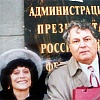The Tussle Over Syria
In
Log in if you are already registered
Putin’s Syrian intervention was limited to areas around the port of Tartus and the Latakia air base, both heavily upgraded by Russia. His aim was not a full occupation, but a gradual expansion of a strategic corridor from Damascus to Aleppo. He did not fear US repercussions. Obama’s 2013 red line back-step had convinced him the president would be passive in the face of aggression. One hour before the intervention began, Obama was haughtily advised to clear the air spaces. Putin did not attempt to conceal his contempt.
Besides protecting Russia’s heavy investments in Syria, Putin was still very much concerned with the more than 2,000 militants from Chechnya and elsewhere who were fighting in Syria, preferring to fight them there rather than in his homeland. He viewed it as in Russia’s national interest to prevent Syria's falling into Islamist hands, as the death of Assad could plunge the country into chaos.
Putin wrestled with the fact that, while Assad had been loyal to him, he had no particular love for this dictator who had killed so many of his own people. The main problem was, who could replace him? Among battling warlords, Assad seemed the only guarantor of stability - something always of extreme importance to Putin. He was firmly resolved that Obama’s policies were not going to turn Syria into a jihadist paradise as they had Libya.
It was time for Putin to turn his attention to the US presidential campaign. He knew that if Clinton won the 2016 presidential race, her Syria policies would likely follow the path charted by one of her principal advisers, Michael Morell. Advocating a robust proxy war in Syria aimed at effecting regime change, Morell’s approach can be summed up as follows: 1) Assad must go; 2) cooperation with Russia is impossible. If necessary, Washington should covertly engage in killing Russians and Iranians in Syria through rebel proxies as it did in Afghanistan; and 3 ) an alliance with “moderate” rebels (if any could be found) was necessary to defeat Assad, but extremists could be used if necessary.
For Putin, the deciding factor was surely Morell’s open advocacy of “killing Russians” in Syria. The clear choice in the election, therefore, was Trump, who had expressed a desire for a new relationship with Russia. Morell’s sentiments, meanwhile, were manifest in that he repeatedly attacked Trump during the campaign as an “unwitting agent of the Russian Federation” and “a threat to our national security.”
Russian analysts, as noted by the journal Sputnik, had by this time observed a “catfight” in Washington between the CIA, the Pentagon, and the State Department over policies towards Syria. While the Pentagon was interested in fighting ISIS, the State Department, together with the CIA, placed the major emphasis on deposing Assad.
The reason Putin knew this may have been because one of the key opponents of this State-CIA goal was Obama’s former Director of the Defense Intelligence Agency, General Mike Flynn. Flynn’s first trip to Russia was in
In December 2015, the general attended a dinner for the Russia Today TV program in Moscow, where, whether by chance or design, he was seated next to Putin. He quickly discovered from the discussion at the table that Putin “has no respect for the United States leadership. Not for the United States, but the leadership.” Neither, in fact, did Flynn. By now he had lost his job over his differences with Obama over the war in Syria.
Two months after his dinner with Putin, Flynn joined the Trump campaign, obviously bringing with him his strong disagreement with Obama’s policy of arming jihadist rebels to unseat Assad.
Firstly published besacenter.org
President of the Institute of Post-Communist Studies and Terrorism
Blog: US, Russia and China: Coping with Rogue States and Terrorists Groups
Rating: 0




